
The lesser kestrel is a small falcon. This species breeds from the Mediterranean across Afghanistan and Central Asia, to China and Mongolia. It is a summer migrant, wintering in Africa and Pakistan and sometimes even to India and Iraq. It is rare north of its breeding range, and declining in its European range. The genus name derives from Late Latin falx, falcis, a sickle, referencing the claws of the bird, and the species name commemorates the German naturalist Johann Friedrich Naumann.

The nankeen kestrel, also known as the Australian kestrel, is a raptor native to Australia and New Guinea. It is one of the smallest falcons, and unlike many, does not rely on speed to catch its prey. Instead, it simply perches in an exposed position, but it also has a distinctive technique of hovering over crop and grasslands.
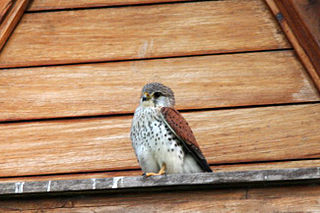
Isolated on various islands around the Indian Ocean, kestrel populations evolved into different species, like Darwin's finches. Behaviour remains similar to other small species of Falco except on (originally) forested Mauritius where kestrels hunt arboreally more like hawks. Due to the scarcity of mammals on oceanic islands, several species have adopted a diet containing many Phelsuma and other geckos. The species can be distinguished by coloration, but all except the banded kestrel share rich brown wings with black spotting. Sexes are alike in color except in the spotted kestrel, where differences are minor. As usual in birds of prey, females are larger than males; considerably so in some of these species as this assists resource partitioning.
This article is one of a series providing information about endemism among birds in the world's various zoogeographic zones. For an overview of this subject see Endemism in birds.
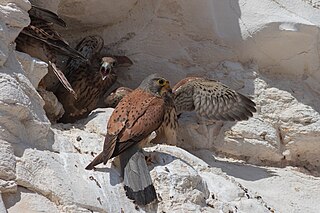
The term kestrel is the common name given to several species of predatory birds from the falcon genus Falco. Kestrels are most easily distinguished by their typical hunting behaviour which is to hover at a height of around 10–20 metres (35–65 ft) over open country and swoop down on ground prey, usually small mammals, lizards or large insects, while other falcons are more adapted for active hunting during flight.

The painted spurfowl is a bird of the pheasant family found in rocky hill and scrub forests mainly in peninsular India. Males are more brightly coloured and spotted boldly in white. Males have two to four spurs while females can have one or two of the spurs on their tarsus. The species is found mainly in rocky and scrub forest habitats unlike the red spurfowl. It is found in the undergrowth in pairs or small groups, escaping by running and rarely taking to the wing when flushed.

The Mauritius kestrel is a bird of prey from the family Falconidae endemic to the forests of Mauritius, where it is restricted to the southwestern plateau's forests, cliffs, and ravines. It is the most distinct of the Indian Ocean kestrels. It colonized its island home to evolve into a distinct species probably during the Gelasian. It is the most distant living species among the western Indian Ocean kestrels.

The rufous-tailed plantcutter, sometimes called the Chilean plantcutter, is a passerine bird of southern South America, now placed in the cotinga family. It is a medium-sized bird about 19 centimetres (7.5 in) long with a long black tail with a red base. Males have greyish-brown upper parts, a chestnut crown and breast, and dark facial markings. Females are similar but lack the chestnut crown and have streaked, buff underparts. There is a wing bar which is white in the male and buff in the female. This is a fairly common species with a wide range, and the International Union for Conservation of Nature has rated its conservation status as being of "least concern".

The greater striped swallow is a large swallow that is native to Africa south of the equator.
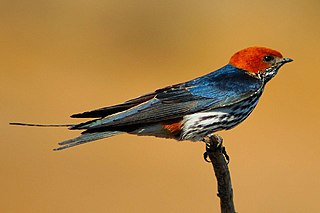
The lesser striped swallow is a large swallow. It breeds in Sub-Saharan Africa from Sierra Leone and southern Sudan south into eastern South Africa. It is partially migratory with South African birds wintering further north. West African birds leave the north of the breeding range in the dry season.

The rufous-winged buzzard is an Asian bird of prey. It is a resident breeder of Indochina, Java and Sulawesi. It is a species of deciduous forest and second growth up to 800 m.
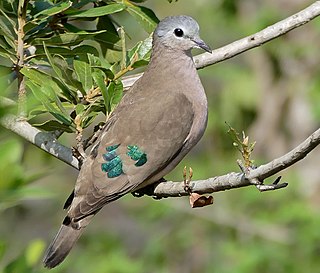
The emerald-spotted wood dove or emerald-spotted dove is a bird of the family Columbidae, resident across eastern and southern Africa. It is a species of open drier deciduous woodland and second growth. It is absent from evergreen rainforests and semidesert areas.

The Malagasy coucal or Madagascar coucal is a species of cuckoo in the family Cuculidae. It is found in Madagascar and in the Seychelles, where it occurs on Aldabra and was formerly present on Assumption Island and Cosmoledo. Its natural habitats are dense vegetation in subtropical or tropical moist lowland forests, mangrove forests, rough grassland, marshes and reedbeds.
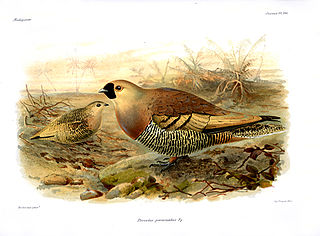
The Madagascar sandgrouse is a species of bird in the family Pteroclidae. It is endemic to Madagascar and is a ground-dwelling short-legged plump bird. The head of the male is brown with a black area surrounding the beak. It has a pinkish-buff coloured breast, a light brown mottled back, brown wings and paler underparts barred with dark brown. The female has a generally duller appearance being cryptically coloured brown with dark specks and bars.

The grey-headed batis is a species of bird in the wattle-eyes family, Platysteiridae, it was previously classified with the Old World flycatchers in the family Muscicapidae. It is found in eastern and central Africa.

The white-headed robin-chat is a species of bird in the family Muscicapidae. It is found in northern Angola and the western Democratic Republic of the Congo. It is threatened by habitat loss, and its IUCN conservation status is the least concern.

The nelicourvi weaver is a species of bird in the family Ploceidae. It is endemic to Madagascar. Together with its closest relative, the sakalava weaver, it is sometimes placed in a separate genus Nelicurvius. A slender, sparrow-like bird, it is 15 cm (5.9 in) long and weighing 20–28 g (0.71–0.99 oz). Breeding males have a black bill and head, brown eyes, yellow collar, grey belly, chestnut-brown lower tail coverts, olive back, and blackish flight feathers edged greenish. Non-breeding males have mottled grey and green heads. In the breeding female the front of the head is yellow and the back olive green, with a broad yellow eyebrow. It builds solitary, roofed, retort-shaped nests, hanging by a rope from a branch, vine or bamboo stem, in an open space. It primarily feeds on insects, looking on its own or in very small groups, often together with long-billed bernieria. Its natural habitat is subtropical or tropical moist lowland and mountain forests. The conservation status of Nelicourvi weaver is least concern according to the IUCN Red List.

The olive-backed woodcreeper is a species of bird in the subfamily Dendrocolaptinae of the ovenbird family Furnariidae. It is found in Bolivia, Colombia, Ecuador, Peru, and Venezuela.

The Aldabra fody is a passerine bird in the family Ploceidae. It is endemic to Aldabra, an atoll northwest of Madagascar, part of Seychelles. Regarded as conspecific with the Comoros fody in the past, it is now recognized as a distinct species by the International Union for the Conservation of Nature (IUCN). Both sexes are yellow in color across much of the body, with breeding males orange-scarlet on the head and neck. The species has a large and powerful bill, used to compete with other birds of Aldabra for food. Nesting occurs over several months, often in introduced coconut palms and Casuarina trees. The Aldabra fody is considered endangered by the IUCN, threatened by predation of nests and drought. Hybridization with the related Madagascar fody has occurred in the past, but is not currently considered a danger to the species.



















